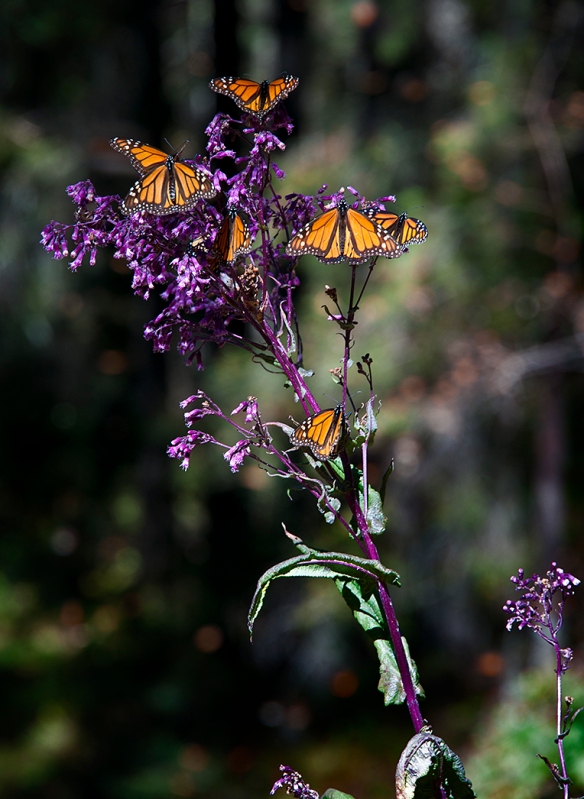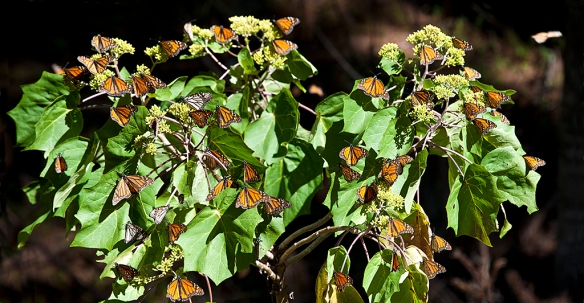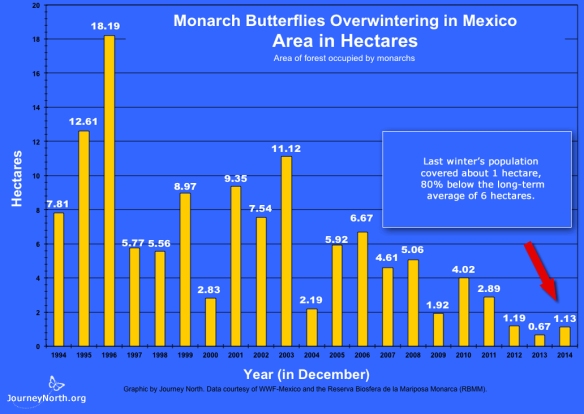Well, the Google Doodle beat me to the punch yesterday, marking the 41st anniversary of the discovery of the overwintering site of the Monarch butterfly. But that’s OK, I’m going ahead with this anyway.
 Monarchs Overwintering in Mexico (2011)
Monarchs Overwintering in Mexico (2011)
By the mid-20th century the existence of the monarch migration had been well known for many years, but not its full route. Every August and September, millions of monarchs in the eastern United States and Canada would start flying south toward Mexico and disappear. Then, around March, they would reappear on a northward journey. The location where they spent those intervening months was unknown. It was one of nature’s great mysteries.
Until January 9, 1975.
In that year, a group of scientists following clues left by tagged butterflies that had fallen on the journey south were led to a place high in the mountains of Mexico’s eastern Sierra Madre Mountains. There they found millions of butterflies clinging to the branches of the oyamel trees that grow at altitudes as high as 11,000-12,000 feet.
The fact that these small creatures can actually make the trip of several thousand miles is not the most amazing part of the story. What is most incredible is that none of them had ever been there before. Yet each year a new torrent of monarchs, separated by three or four generations from those that flew there the previous year, finds its way to those same oyamel trees.
I became entranced with this story in 2001, after reading “Four Wings and a Prayer” by Sue Halpern who traveled to Mexico in a truck with legendary monarch tracker Bill Calvert and experienced first-hand the spectacle of the monarch migration.
My own journey started shortly afterwards with a trip to Cape May, New Jersey, a key crossing point for the southbound monarchs over Delaware Bay. Butterfly researchers at the Cape May Bird Observatory demonstrated the technique of tagging the monarchs and how the tracking depends on anonymous individuals who find a tagged butterfly and report the information of where and when to research centers.
Tagged Monarch Before Release (2001)
A few days later, I caught up with a researcher in Lorton, Virginia who was tagging southbound monarchs in a field of yellow wildflowers (image below). He had almost
Migrating Monarch, Lorton VA (2001)
reached his annual goal of 500 taggings, but was despondent over the fact that this waystation for the monarchs was about to become a shopping center.
Lorton, Virginia (2001)
Seven years later, I was at Pictured Rocks National Lakeshore, on the south shore of Lake Superior, when I spotted a few flashes of orange. It was a pair of migrating monarchs just arriving from their 100-mile-plus flight across the great lake from Canada. They still were over 2,500 miles from their destination.
Migrating Monarch, Pictured Rocks National Lakeshore, MI (2008)
In the fall of 2010, a friend called asking if I would like to join her on a trip to see the overwintering sites in Mexico. My answer was quick and the following January, we found ourselves on a long bus ride from Mexico City to the mountain village of Angangueo. But this was just the first of many transportation modes we would use in the coming days such as the back of pick-up trucks, riding horses, and finally hiking on our own at lung-busting (to us at least) altitudes of 11,000 feet and higher.
Getting Closer, but a Tough Hike Awaits (2011)
But it was all worth it. Photographs really can’t communicate the scale of the scenes we witnessed. There are so many butterflies clustered on the trees that the branches bend downward from the weight, occasionally even breaking.The image below shows a small section of a stand of trees in one of the preserves. Imagine that no matter where you look from this position, all the trees surrounding you are covered from top to bottom with what seem like orange leaves but really are butterflies.
Monarch Clusters on Oyamel Trees, Mexico (2011)
Mexico does try to protect the sanctuaries, although illegal logging is one of many serious threats. But on the positive side they enforce strict (5 mph) speed limits on a highway that occasionally is also used by the monarchs when searching for water outside the preserves.
Monarch Crossing, Mexico (2011)
An equally serious threat is the loss of habitat in the United States. Remember that shopping center in Lorton, Virginia? There has been a steady decline in the numbers of monarchs reaching the preserves over the past decade, but there was a slight uptick last
Chart of Monarch Counts in Mexico (1994-2014)
year. Preliminary estimates for this winter are cautiously optimistic, with hopes that they might reach the levels of 2011, when I was there. Keep your fingers crossed and….
Keep Shooting….












Wonderful photos and very informative post. I am keeping my fingers crossed!
LikeLiked by 1 person
Thanks, Denise. They should be announcing the “census” results sometime this month. Hopefully, the news will be positive.
LikeLiked by 1 person
What an amazing post, fantastic photos, and a fantastic journey! Both for the butterfly and you. It’s sad to see this decline. We have a sanctuary just south of us in Pacific Grove and I visited it last year. Unfortunately I was late and couldn’t get much in the way of photos. I wonder if there is a decline here as well.
LikeLiked by 1 person
Thanks for your comments, Laura. I’m glad you liked it. From what I understand there has been a similar decline of the western monarch population, with some estimates suggesting a 50% decline over the avaerage population numbers for the last 20 years. Here is a link to some further information: http://www.xerces.org/western-monarchs/
LikeLiked by 1 person
Oh dear. It is much like bees….they are disappearing. I fear what is in store for generations to come.
LikeLike
Wow!! Great. I didnât remember about the guy in Lorton
Laurie
LikeLike
Robin, this is absolutely fascinating. How lucky you are to have experienced the migration in Mexico, and how lucky are we to see your wonderful photographs. So sad about the building of yet another shopping center and the negative consequences on these amazing butterflies. Thanks for sharing the story!
LikeLiked by 1 person
Thanks, Stacy. I appreciate your thoughts. It wasn’t the easiest trip I’ve made, but it was truly memorable.
LikeLiked by 1 person
Sometimes the most difficult is the most rewarding!
LikeLiked by 1 person
Amazing!
LikeLiked by 1 person
Thanks!
LikeLike
It never ceases to amaze me, the journey these tiny creatures make every year. I can only imagine the wonder of seeing their Mexican habitat in person!
LikeLiked by 1 person
Thanks very much. It was an amazing experience, no doubt about it. Scientists still don’t have a complete understanding of how the monarchs find their way to those specific spots.
LikeLiked by 1 person
Thanks Robin, enjoyed this very much. Michele
Sent from my iPad
>
LikeLiked by 1 person
Thanks, Michele. I’m glad you liked it.
LikeLike
Thanks for the incredible story, and for ending with a shot of hope.
LikeLiked by 1 person
Thanks very much. I’ll try to stay alert for the report and if I see it, will include an update in a furture post.
LikeLike
Wow. Just wow. That image of riders on horseback through the forest is absolutely wonderful.
LikeLiked by 1 person
Thanks very much. The dust kicked up by our horses made an eerie scene as we slowly made our way up the trail. It was a cool, crisp day and the horses were breathing hard from the effort. After about an hour, we dismounted and hiked the last half mile or so before we reached the monarchs.
LikeLiked by 1 person
What an amazing and informative post, Robin. I never knew of the migration. It must be an astounding experience to see the monarchs in such huge numbers.
LikeLiked by 1 person
Thanks, Chris. Yes, unlike anything I’ve seen before. I’m glad I was able to witness it.
LikeLiked by 1 person
Interesting to read because I’m currently reading a novel (Flight Behaviour- Barbara Kingsolver) which uses the Monarch’s story as background. 🙂
LikeLiked by 1 person
Thanks very much. Quite a coincidence. I’ll have to check that out.
LikeLiked by 1 person
Pingback: Low Light Photography (Part 3) | photographybykent